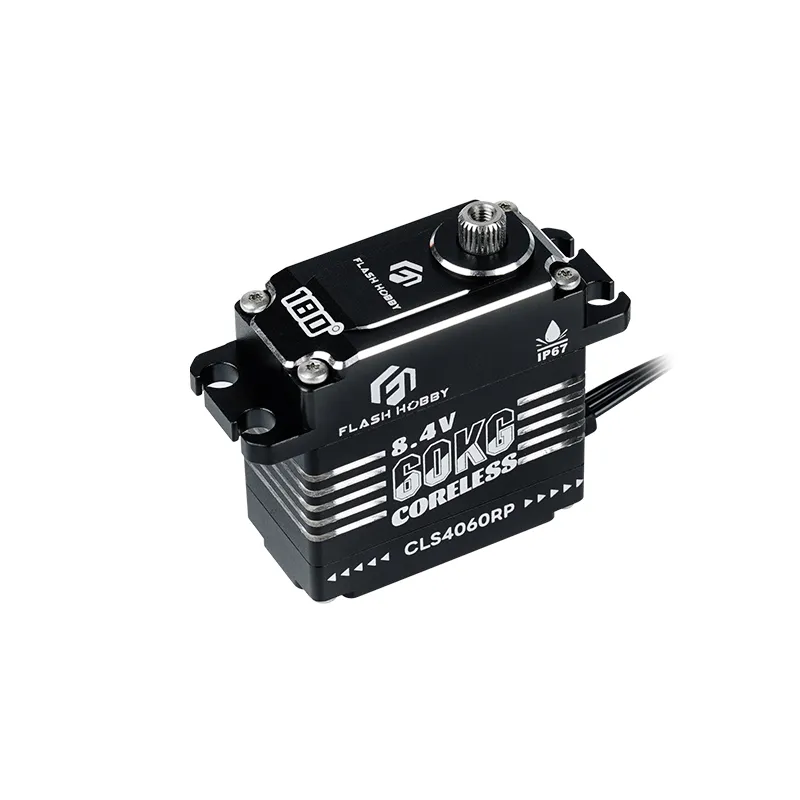Characteristics of Standard Servo
2024-07-28
Standard servos are widely used in various applications, including robotics, remote-controlled vehicles, and automation systems. They are essential components for precise control of angular position, speed, and torque. Here’s a detailed overview of the characteristics of standard servos:
1. Basic Components
- Motor: The core component of a servo, usually a small DC motor, that drives the movement.
- Gearbox: Reduces the motor's speed and increases its torque, providing precise control of the output shaft.
- Control Circuit: Includes a feedback mechanism and control electronics to regulate the motor's position and speed.
- Potentiometer: A variable resistor that provides feedback on the servo's position, allowing for precise control.
2. Operation Principle
- Pulse Width Modulation (PWM): Standard servos are controlled by PWM signals, where the width of the pulse determines the position of the servo's output shaft.
- Feedback System: The potentiometer or encoder feedback system continuously monitors the shaft's position and adjusts the motor's movement to maintain the desired position.
3. Mechanical Characteristics
- Torque: The amount of rotational force the servo can exert, typically measured in kg-cm (kilogram-centimeters) or oz-in (ounce-inches).
- Speed: The rate at which the servo can move from one position to another, often specified in seconds per 60 degrees of movement.
- Range of Motion: The angular range through which the servo can rotate, commonly 180 degrees but can vary (e.g., 90 degrees or continuous rotation for specific applications).
4. Electrical Characteristics
- Voltage Range: Standard servos usually operate within a specified voltage range, typically 4.8V to 6V, though some may handle higher voltages.
- Current Consumption: Varies depending on the servo's torque and speed specifications, with higher torque servos consuming more current.
5. Control Signal
- PWM Signal: Standard servos require a PWM signal with a frequency typically around 50 Hz (20 ms period). The pulse width (usually between 1 ms to 2 ms) determines the servo's position.
- Resolution: The precision of the servo's position control, which depends on the control signal's resolution and the feedback system's accuracy.
6. Physical Size and Form Factor
- Dimensions: Available in various sizes, from micro servos (small and lightweight) to standard and high-torque servos (larger and heavier).
- Mounting: Usually equipped with mounting holes and a standard horn or arm for attachment to mechanical systems.
7. Durability and Reliability
- Build Quality: Generally robust and designed to withstand repetitive motion and moderate loads.
- Materials: Often made from plastic or metal gears, with metal gears providing higher durability and strength.
8. Applications
- Robotics: Used in robotic arms, mobile robots, and autonomous systems for precise control of movement.
- Remote-Controlled Vehicles: Common in RC cars, planes, and helicopters for controlling steering, throttle, and other functions.
- Automation Systems: Employed in automated machinery and control systems for accurate positioning and movement.
9. Types and Variations
- Analog Servos: Traditional type of servo that uses analog electronics for control. Generally slower and less precise compared to digital servos.
- Digital Servos: Use digital signal processing for more accurate and faster response. Offer better performance, precision, and torque control.
10. Maintenance and Care
- Regular Inspection: Check for wear and tear, particularly in the gears, to ensure proper functioning.
- Proper Calibration: Ensure the servo is properly calibrated and aligned to avoid issues with movement and positioning.
- Avoid Overloading: Do not exceed the servo's specified torque limits to prevent damage or reduced lifespan.
11. Integration and Compatibility
- Microcontrollers and Controllers: Easily integrated with microcontrollers, RC receivers, and servo controllers for various control applications.
- Programming: Can be programmed or configured through software tools or control boards to achieve desired behaviors and functions.
Standard servos are versatile components that provide precise control and reliable performance in a wide range of applications. Understanding their characteristics helps in selecting the right servo for specific needs and ensuring optimal operation.



